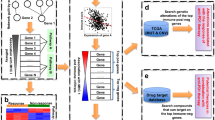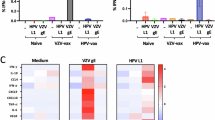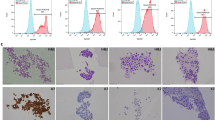Abstract
The complex nature of the immunosuppressive tumor microenvironment (TME) requires multi-agent combinations for optimal immunotherapy. Here we describe multiplex universal combinatorial immunotherapy via gene silencing (MUCIG), which uses CRISPR–Cas13d to silence multiple endogenous immunosuppressive genes in the TME, promoting TME remodeling and enhancing antitumor immunity. MUCIG vectors targeting four genes delivered by adeno-associated virus (AAV) (Cd274/Pdl1, Lgals9/Galectin9, Lgals3/Galectin3 and Cd47; AAV-Cas13d-PGGC) demonstrate significant antitumor efficacy across multiple syngeneic tumor models, remodeling the TME by increasing CD8+ T-cell infiltration while reducing neutrophils. Whole transcriptome profiling validates the on-target knockdown of the four target genes and shows limited potential off-target or downstream gene alterations. AAV-Cas13d-PGGC outperforms corresponding shRNA treatments and individual gene knockdown. We further optimize MUCIG by employing high-fidelity Cas13d (hfCas13d), which similarly showed potent gene silencing and in vivo antitumor efficacy, without weight loss or liver toxicity. MUCIG represents a universal method to silence multiple immune genes in vivo in a programmable manner, offering broad efficacy across multiple tumor types.
This is a preview of subscription content, access via your institution
Access options
Access Nature and 54 other Nature Portfolio journals
Get Nature+, our best-value online-access subscription
27,99 € / 30 days
cancel any time
Subscribe to this journal
Receive 12 print issues and online access
209,00 € per year
only 17,42 € per issue
Buy this article
- Purchase on SpringerLink
- Instant access to full article PDF
Prices may be subject to local taxes which are calculated during checkout






Similar content being viewed by others
Data availability
All data generated or analyzed during this study are included in this Article and its Supplementary Information. Data and statistics of nonNGS experiments are provided in an Excel file in the Supplementary Information. Raw sequencing data of single-cell RNA-Seq, pool screen and off-target bulk RNA-Seq have been deposited to the Gene Expression Omnibus with accession number GSE269516 ref. 62. Processed data for genomic sequencing and gene expression (NGS experiments) are provided as processed quantifications in Supplementary Data. All other data and materials that support the findings of this research are available to the academic community upon reasonable request to the corresponding author. Source data are provided with this paper.
Code availability
All codes used for this study are available via Code Ocean at https://codeocean.com/capsule/0336604/tree/v1 (ref. 63).
Change history
03 February 2025
A Correction to this paper has been published: https://doi.org/10.1038/s41587-025-02576-1
References
Rabinovich, G. A., Gabrilovich, D. & Sotomayor, E. M. Immunosuppressive strategies that are mediated by tumor cells. Annu. Rev. Immunol. 25, 267–296 (2007).
Binnewies, M. et al. Understanding the tumor immune microenvironment (TIME) for effective therapy. Nat. Med. 24, 541–550 (2018).
Tormoen, G. W., Crittenden, M. R. & Gough, M. J. Role of the immunosuppressive microenvironment in immunotherapy. Adv. Radiat. Oncol. 3, 520–526 (2018).
Kim, R., Emi, M., Tanabe, K. & Arihiro, K. Tumor-driven evolution of immunosuppressive networks during malignant progression. Cancer Res. 66, 5527–5536 (2006).
Munn, D. H. & Bronte, V. Immune suppressive mechanisms in the tumor microenvironment. Curr. Opin. Immunol. 39, 1–6 (2016).
Buchbinder, E. I. & Desai, A. CTLA-4 and PD-1 pathways: similarities, differences, and implications of their inhibition. Am. J. Clin. Oncol. 39, 98–106 (2016).
Pardoll, D. M. The blockade of immune checkpoints in cancer immunotherapy. Nat. Rev. Cancer 12, 252–264 (2012).
Wei, S. C., Duffy, C. R. & Allison, J. P. Fundamental mechanisms of immune checkpoint blockade therapy. Cancer Discov. 8, 1069–1086 (2018).
Sharma, P. et al. The next decade of immune checkpoint therapy. Cancer Discov. 11, 838–857 (2021).
Li, X., Shao, C., Shi, Y. & Han, W. Lessons learned from the blockade of immune checkpoints in cancer immunotherapy. J. Hematol. Oncol. 11, 31 (2018).
Wolchok, J. D. et al. Nivolumab plus ipilimumab in advanced melanoma. N. Engl. J. Med. 369, 122–133 (2013).
Hammers, H. et al. Phase I study of nivolumab in combination with ipilimumab in metastatic renal cell carcinoma (MRCC). Annal. Oncol. 42, 3033–3046 (2014).
Rotte, A. Combination of CTLA-4 and PD-1 blockers for treatment of cancer. J. Exp. Clin. Cancer Res. 38, 255 (2019).
Sharma, P., Hu-Lieskovan, S., Wargo, J. A. & Ribas, A. Primary, adaptive, and acquired resistance to cancer immunotherapy. Cell 168, 707–723 (2017).
Boettcher, M. & McManus, M. T. Choosing the right tool for the job: RNAi, TALEN, or CRISPR. Mol. Cell 58, 575–585 (2015).
Granados-Riveron, J. T. & Aquino-Jarquin, G. CRISPR-Cas13 precision transcriptome engineering in cancer. Cancer Res. 78, 4107–4113 (2018).
Konermann, S. et al. Transcriptome engineering with RNA-targeting type VI-D CRISPR effectors. Cell 173, 665–676 e614 (2018).
Yan, W. X. et al. Cas13d is a compact RNA-targeting type VI CRISPR effector positively modulated by a WYL-___domain-containing accessory protein. Mol. Cell 70, 327–339 e325 (2018).
Tieu, V. et al. A versatile CRISPR–Cas13d platform for multiplexed transcriptomic regulation and metabolic engineering in primary human T cells. Cell 187, 1278–1295 e1220 (2024).
Wei, J. et al. Deep learning and CRISPR-Cas13d ortholog discovery for optimized RNA targeting. Cell Syst. 14, 1087–1102 (2023).
Morelli, K. H. et al. An RNA-targeting CRISPR–Cas13d system alleviates disease-related phenotypes in Huntington’s disease models. Nat. Neurosci. 26, 27–38 (2023).
Tang, X. E., Tan, S. X., Hoon, S. & Yeo, G. W. Pre-existing adaptive immunity to the RNA-editing enzyme Cas13d in humans. Nat. Med. 28, 1372–1376 (2022).
Wessels, H. H. et al. Massively parallel Cas13 screens reveal principles for guide RNA design. Nat. Biotechnol. 38, 722–727 (2020).
Shi, P. et al. Collateral activity of the CRISPR/RfxCas13d system in human cells. Commun. Biol. 6, 334 (2023).
Kelley, C. P., Haerle, M. C. & Wang, E. T. Negative autoregulation mitigates collateral RNase activity of repeat-targeting CRISPR-Cas13d in mammalian cells. Cell Rep. 40, 111226 (2022).
Hart, S. K. et al. Low copy CRISPR-Cas13d mitigates collateral RNA cleavage. Preprint at bioRxiv https://doi.org/10.1101/2024.05.13.594039 (2024).
Wang, D., Tai, P. W. L. & Gao, G. Adeno-associated virus vector as a platform for gene therapy delivery. Nat. Rev. Drug Discov. 18, 358–378 (2019).
Naso, M. F., Tomkowicz, B., Perry, W. L. 3rd & Strohl, W. R. Adeno-associated virus (AAV) as a vector for gene therapy. BioDrugs 31, 317–334 (2017).
Bell, C. L. et al. The AAV9 receptor and its modification to improve in vivo lung gene transfer in mice. J. Clin. Invest. 121, 2427–2435 (2011).
Ru, B. et al. TISIDB: an integrated repository portal for tumor-immune system interactions. Bioinformatics 35, 4200–4202 (2019).
Manguso, R. T. et al. In vivo CRISPR screening identifies Ptpn2 as a cancer immunotherapy target. Nature 547, 413–418 (2017).
Wang, X. et al. In vivo CRISPR screens identify the E3 ligase Cop1 as a modulator of macrophage infiltration and cancer immunotherapy target. Cell 184, 5357–5374 e5322 (2021).
Ishizuka, J. J. et al. Loss of ADAR1 in tumours overcomes resistance to immune checkpoint blockade. Nature 565, 43–48 (2019).
Shen, L., Evel-Kabler, K., Strube, R. & Chen, S. Y. Silencing of SOCS1 enhances antigen presentation by dendritic cells and antigen-specific anti-tumor immunity. Nat. Biotechnol. 22, 1546–1553 (2004).
Lawson, K. A. et al. Functional genomic landscape of cancer-intrinsic evasion of killing by T cells. Nature 586, 120–126 (2020).
Crosby, E. J. et al. Complimentary mechanisms of dual checkpoint blockade expand unique T-cell repertoires and activate adaptive anti-tumor immunity in triple-negative breast tumors. Oncoimmunology 7, e1421891 (2018).
Tang, Z., Kang, B., Li, C., Chen, T. & Zhang, Z. GEPIA2: an enhanced web server for large-scale expression profiling and interactive analysis. Nucleic Acids Res. 47, W556–W560 (2019).
Mosely, S. I. et al. Rational selection of syngeneic preclinical tumor models for immunotherapeutic drug discovery. Cancer Immunol. Res. 5, 29–41 (2017).
van Spriel, A. B. et al. A regulatory role for CD37 in T cell proliferation. J. Immunol. 172, 2953–2961 (2004).
Kong, Y. et al. T-cell immunoglobulin and ITIM ___domain (TIGIT) associates with CD8+ T-cell exhaustion and poor clinical outcome in AML patients. Clin. Cancer Res. 22, 3057–3066 (2016).
Grzywa, T. M. et al. Myeloid cell-derived arginase in cancer immune response. Front. Immunol. 11, 938 (2020).
Gómez-Herranz, M. et al. The effects of IFITM1 and IFITM3 gene deletion on IFNγ stimulated protein synthesis. Cell Signal. 60, 39–56 (2019).
Srikrishna, G. S100A8 and S100A9: new insights into their roles in malignancy. J. Innate Immun. 4, 31–40 (2012).
Pratt, A. J. & MacRae, I. J. The RNA-induced silencing complex: a versatile gene-silencing machine. J. Biol. Chem. 284, 17897–17901 (2009).
Tong, H. et al. High-fidelity Cas13 variants for targeted RNA degradation with minimal collateral effects. Nat. Biotechnol. 41, 108–119 (2023).
Zhou, F. Molecular mechanisms of IFN-gamma to up-regulate MHC class I antigen processing and presentation. Int. Rev. Immunol. 28, 239–260 (2009).
Baghban, R. et al. Tumor microenvironment complexity and therapeutic implications at a glance. Cell Commun. Signal. 18, 59 (2020).
Ribeiro Franco, P. I., Rodrigues, A. P., de Menezes, L. B. & Pacheco Miguel, M. Tumor microenvironment components: allies of cancer progression. Pathol. Res. Pract. 216, 152729 (2020).
Motz, G. T. & Coukos, G. Deciphering and reversing tumor immune suppression. Immunity 39, 61–73 (2013).
Ni, G. et al. Targeting interleukin-10 signalling for cancer immunotherapy, a promising and complicated task. Hum. Vaccin. Immunother. 16, 2328–2332 (2020).
Biswas, S. et al. Inhibition of TGF-beta with neutralizing antibodies prevents radiation-induced acceleration of metastatic cancer progression. J. Clin. Invest. 117, 1305–1313 (2007).
Deyle, D. R. & Russell, D. W. Adeno-associated virus vector integration. Curr. Opin. Mol. Ther. 11, 442–447 (2009).
McGeary, S. E. et al. The biochemical basis of microRNA targeting efficacy. Science 366, eaav1741 (2019).
Garcia, D. M. et al. Weak seed-pairing stability and high target-site abundance decrease the proficiency of lsy-6 and other microRNAs. Nat. Struct. Mol. Biol. 18, 1139–1146 (2011).
Grimson, A. et al. MicroRNA targeting specificity in mammals: determinants beyond seed pairing. Mol. Cell 27, 91–105 (2007).
Lewis, B. P., Burge, C. B. & Bartel, D. P. Conserved seed pairing, often flanked by adenosines, indicates that thousands of human genes are microRNA targets. Cell 120, 15–20 (2005).
Wessels, H.-H. et al. Prediction of on-target and off-target activity of CRISPR–Cas13d guide RNAs using deep learning. Nat. Biotechnol. 42, 628–637 (2024).
Joung, J. et al. Genome-scale CRISPR-Cas9 knockout and transcriptional activation screening. Nat. Protoc. 12, 828–863 (2017).
Chen, S., Zhou, Y., Chen, Y. & Gu, J. fastp: an ultra-fast all-in-one FASTQ preprocessor. Bioinformatics 34, i884–i890 (2018).
Dobin, A. et al. STAR: ultrafast universal RNA-seq aligner. Bioinformatics 29, 15–21 (2013).
Camacho, C. et al. BLAST+: architecture and applications. BMC Bioinf. 10, 421 (2009).
Zhang, F., et al. Multiplexed inhibition of immunosuppressive genes with Cas13d for combinatorial cancer immunotherapy. GEO https://www.ncbi.nlm.nih.gov/geo/query/acc.cgi?acc=GSE269516 (2024).
Zhang, F., Chow, R. D., He, E., Dong, C. & Chen, S. Multiplexed inhibition of immunosuppressive genes with Cas13d for on-demand combinatorial cancer immunotherapy. Code Ocean https://codeocean.com/capsule/0336604/tree/v1 (2024).
Acknowledgements
We thank all members of the Chen laboratory as well as various colleagues in Yale Genetics, SBI, CSBC, MCGD, Immunobiology, BBS, YCC, YSCC and CBDS for assistance and/or discussions. We thank various Yale Core Facilities such as YARC, WCFC, YCGA, HPC and WCAC for technical support. S.C. is supported by NIH/NCI/NIDA (grant numbers DP2CA238295, R01CA231112, R33CA225498, RF1DA048811 and R33CA281702), DoD (grant numbers W81XWH-17-1-0235, W81XWH-20-1-0072, W81XWH-21-1-0514 and HT94252310472), a Damon Runyon Dale Frey Award (DFS-13-15), the Melanoma Research Alliance (grant numbers 412806 and 16-003524), the Cancer Research Institute (Cancer Research Institute Lloyd J. Old STAR Award (CRI4964), CLIP), the AACR (17-20-01-CHEN), The V Foundation (grant number V2017-022), the Alliance for Cancer Gene Therapy, Sontag Foundation (DSA), the Pershing Square Sohn Cancer Research Alliance, Dexter Lu, the Ludwig Family Foundation, the Blavatnik Family Foundation and the Chenevert Family Foundation. G.W. is supported by CRI Irvington and RJ Anderson postdoctoral fellowships. R.C. is supported by NIH MSTP training grant number T32GM007205 and NRSA fellowship (grant number F30CA250249). C.D. is supported by Boehringer Ingelheim Biomedical Data Science Fellowship. N.V. is supported by American Board of Radiology’s B. Leonard Holman Research Pathway Fellowship and the ASTRO Radiation Oncology Seed Grant.
Author information
Authors and Affiliations
Contributions
Conceptualization: S.C. Design: F.Z., G.W., R.C. and S.C. Experimental lead: F.Z., G.W., and E.H. Analytic lead: R.C. and C.D. Experimental and analytic assistance and support: S.X., D.M., Y.F., M.M., X.T. and Y.Z. Paper preperation: F.Z., R.C., G.W., C.D., S.X., N.V. and S.C. Supervision and funding: S.C.
Corresponding authors
Ethics declarations
Competing interests
S.C. is a (co)founder of EvolveImmune Tx, Cellinfinity Bio, MagicTime Med and Chen Consulting. A patent application (WO2023196711A3, worldwide) has been filed by Yale University related to this study. The other authors declare no competing interests.
Peer review
Peer review information
Nature Biotechnology thanks Justin Eyquem, Hui Yang and the other, anonymous, reviewer(s) for their contribution to the peer review of this work.
Additional information
Publisher’s note Springer Nature remains neutral with regard to jurisdictional claims in published maps and institutional affiliations.
Supplementary information
Supplementary Information
Supplementary Figs. 1–16.
Supplementary Data 1
All supplementary Excel files.
Source data
Source Data Figs. 1–6
Source data and statistics of nonNGS-type data in the Sup_excel_files.zip file.
Rights and permissions
Springer Nature or its licensor (e.g. a society or other partner) holds exclusive rights to this article under a publishing agreement with the author(s) or other rightsholder(s); author self-archiving of the accepted manuscript version of this article is solely governed by the terms of such publishing agreement and applicable law.
About this article
Cite this article
Zhang, F., Chow, R.D., He, E. et al. Multiplexed inhibition of immunosuppressive genes with Cas13d for combinatorial cancer immunotherapy. Nat Biotechnol (2025). https://doi.org/10.1038/s41587-024-02535-2
Received:
Accepted:
Published:
DOI: https://doi.org/10.1038/s41587-024-02535-2
This article is cited by
-
Precise RNA targeting with CRISPR–Cas13d
Nature Biotechnology (2025)
-
Turn cold tumors hot by reprogramming the tumor microenvironment
Nature Biotechnology (2025)
-
Multiplex targeting of immune-modulating genes in cancer
Nature Immunology (2025)



